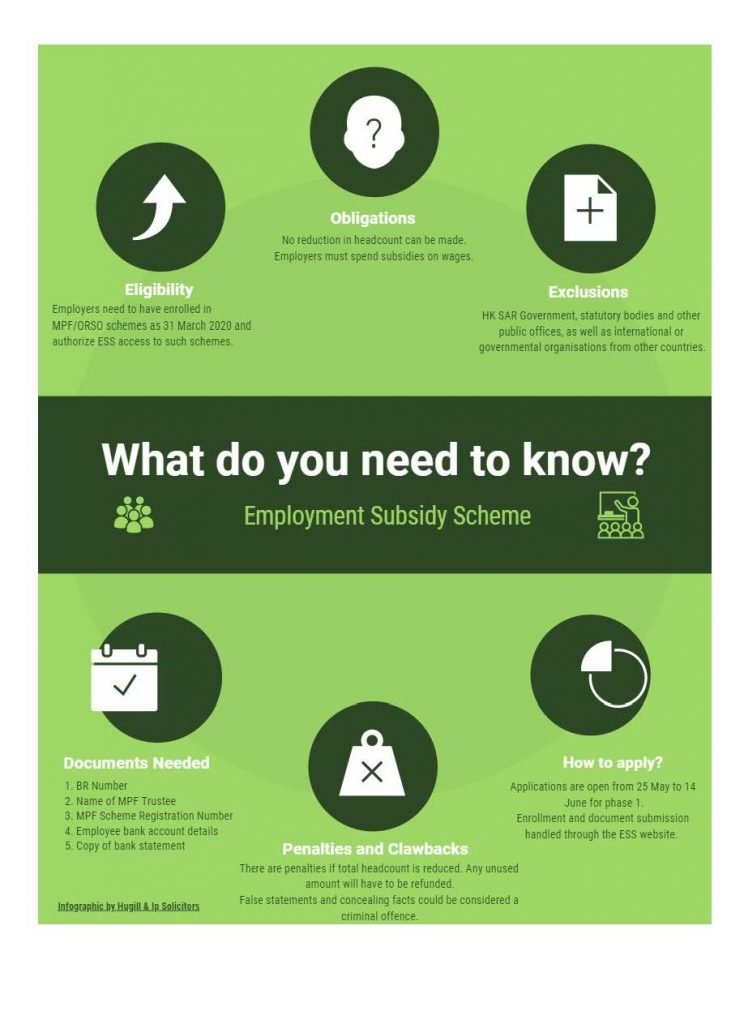When the Employment Support Scheme (“ESS”) was first announced, hope was given to struggling employers and their cashflow issues during COVID-19. The government has provided further clarity including, most importantly, when the application process will open – 25 May 2020 to 14 June 2020.
Our articles “ New Relief Measures during COVID-19 Pandemic: Hong Kong Launches Employment Support Scheme” and “Employment Support Scheme (ESS) Update”, have monitored the changes and updates with regards to the scheme. This article aims to keep you updated on latest developments. We recap the main requirements and considerations in the infographic here below:
Subsidy calculation
The Government will calculate the amount of each subsidy, generally, through obtaining employees MPF information. Employers who set up occupational retirement schemes exempted from MPF will also be eligible, but further information regarding these may be required for subsidy calculation.
Generally, the government will calculate subsidies using basic salary information provided. The subsidy offered will be 50% of basic salary paid in the “specified month” with the wage capped at HK$18,000.
If an employee is over 65 and employers make voluntary contributions but have not disclosed employee’s basic salary, then a different calculation method will be used. The wage subsidy will be calculated by multiplying the amount of contributions in the “specified month” by 10 (with a cap at HK$9,000).
Clawback
We now know that the Government do not plan on gifting the full amount if it is not needed. If employers, who are given a subsidy, do not require the full amount of the subsidy they will be expected to pay back the amount not spent. This is being referred to as “clawback” and will be assessed on a monthly basis (i.e. the amount not spent on the wage subsidies received for a particular month during the subsidy period (June to August) to pay the wages of employees in the same month).
Commitment
The employers must sign a commitment letter promising that:
- number of employees on payroll between June and August will not be smaller than it was in March, this includes employees on unpaid leave;
- the money received will go solely on employee wages.
Questions remain over how the Government will monitor employers use of subsidies. However, they have announced a review and monitoring mechanism. Information regarding the subsidies, such as employers who have received subsidies, the total number of beneficiary employees and the amount of subsidies, will be transparent. Employees or members of the public will be able to use this information to report abuses or violations.
Penalties
What was to be considered as a reduction in employee headcount and the related penalties was not made clear when the first announcement of the ESS was made. The Government have now provided further details on how employers will be penalised if their employee headcount is reduced.
The total amount of the penalty will depend on the headcount reduction and the penalty percentage and will be calculated using the following formula:
[Subsidies Received X Headcount Reduction] X Penalty Percentage
The penalty percentage that an employer is subject to will depend on the total amount of staff they have. This varies depending how many employees there are. For example, if there are less than 10 employees then the penalty percentage will be 10%, if you have 500 or more employees it will be 80%.
As there will be a second tranche of the subsidy, The Secretary for Labour & Welfare Dr. Law Chi-Kwong stated that any penalty or clawback from the first tranche may be deducted in the second tranche. If a penalty or clawback is incurred during the second tranche of the subsidy, the Government will require direct payment
Authorization and Information required
MPF Applicants will have to authorize the ESS processing agent to receive MPF records. The MPF trustees must also provide authorization.
Once authorization has been received the certificates can be sent to the agent to calculate the subsidy amount.
When making online applications the employers (or self- employed person) will have to provide:
- Business Registration Number
- Name of the MPF Trustee
- Name of MPF Scheme and Scheme Registration/Participation Number
- Bank account number of the employer
- Scanned copy of the bank statements
MPF exempted ORSO Scheme members will have to provide similar information relating to the ORSO Scheme (e.g. Registration Numbers, MPF Exemption Numbers, scanned copy of Exemption Certificate). They will also have to fill out a designated form to provide information on eligible employees.
Legal Liability
The application must be truthfully completed and “true, complete and accurate information” must be submitted. Failing to do so could lead to applications be rejected. Knowingly providing false information will be a criminal offense.
When will the subsidies be received?
The Government have said that once an application is made, it should take 3-4 weeks for the subsidies to be received. Although this may take longer for application involving ORSO schemes.
Some organisations are excluded from the scheme, including government offices and employers involved in public affairs. For a full list of excluded categories please follow this link.
It remains to be seen how practical and thorough the processes surrounding the scheme will be. The next 3 months will uncover any inefficiencies and may well lead to further changes. Stay updated.
For full information, you can also consult the Government website by clicking here.
If you would like to understand more on legal implications connected to Employment issues, you can contact the partner heading our Employment & Business Immigration practice – Adam Hugill.
This article is for information purposes only. Its contents do not constitute legal advice and readers should not regard this article as a substitute for detailed advice in individual instances.




